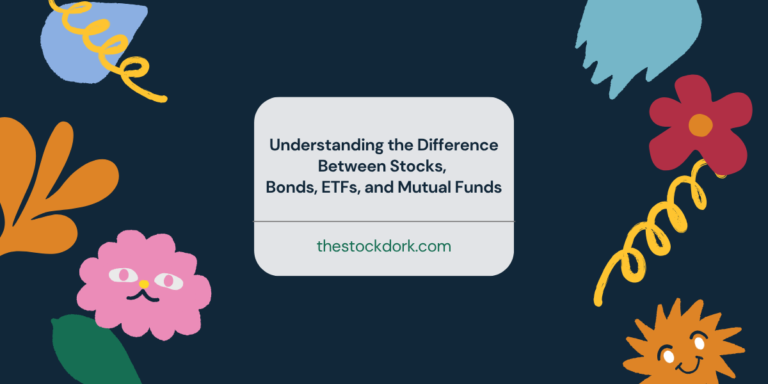A Simple Starting Point for New Investors
Many people begin their investing journey with a basic but important question, which is understanding the difference between stocks and bonds and the difference between ETFs and mutual funds. These four investment vehicles are the foundation of most portfolios, yet they can feel confusing when you first learn about them. New investors often hear terms like equity investments, fixed income investments, index funds, and diversification strategy, but without context these ideas feel abstract. This guide breaks everything down, so the concepts become familiar and easy to understand.
The goal is to help beginners build confidence. By the end, you will understand how each investment works, why investors use them, and how they fit together in a simple portfolio. You will learn the basics of risk, returns, and market exposure in a way that supports long term investing without overwhelming you.

Why Different Types of Investments Exist
Before looking at these individual investments, it helps to understand why so many types of investment securities exist in the first place. Investors have different goals, different timelines, and different comfort levels with risk. A person saving for retirement may want steady growth over several decades. Another may want safety because they plan to use their money soon. A third person may want both growth and stability.
The market offers different investment vehicles to meet these needs. Stocks offer growth tied to a company’s success. Bonds offer steadier returns because they pay interest. ETFs and mutual funds offer diversification by combining many investments into one place. When you understand what each investment does, you can build a portfolio that matches your goals through a process called asset allocation. Thoughtful asset allocation helps you decide how to balance growth and stability in your portfolio, and understanding these four investment types gives you the tools to make informed decisions.
Understanding Stocks, Your First Step into Ownership
Stocks are often the first investment people hear about. A share of stock represents a small piece of ownership in a company. When you own a stock, you own a tiny piece of that business. If the company earns profits, expands its products, increases its customer base, or becomes more efficient, the value of your shares can increase. Investors use stocks because they offer the potential for higher long term returns.
To understand stocks more clearly, picture yourself owning a small piece of a well-known company. If that company releases a successful product or grows its revenue, the stock price may rise. When that happens, your investment grows too. This is the concept behind stock investing. Stocks rise and fall based on supply and demand in the market, and on expectations for future growth. The movement of stock prices can feel fast at times, but the idea itself is simple. When businesses grow, stock owners benefit.
Stocks fall under the category of equity investments because you own equity in the company. Equity carries more risk than fixed income investments such as bonds, which is why stocks tend to move more day to day. The reward for accepting this movement is the potential for higher returns over long periods. This is a key part of the risk and return comparison of stocks and bonds.
When beginners compare stocks vs mutual funds or stocks vs ETFs, they often realize that buying individual stocks requires more research. You must understand the company, its financial health, its products, and the potential challenges it may face. This can be exciting for some people but overwhelming for others. Stocks offer control and growth, but they also require attention and patience.
Understanding Bonds, A Steady Source of Income
Bonds work differently from stocks. A bond is a loan that you provide to a company or a government. When you buy a bond, you agree to lend money for a set period. In return, the issuer pays interest at regular intervals. When the bond reaches its maturity date, the issuer aims to return the full amount you invested.
This predictable flow of interest payments is why bonds are known as fixed income investments. The income does not depend on a company’s profits. It depends on the agreement written into the bond. Bonds can still change in price as interest rates move, but the day to day changes are usually much smaller than stock price movements. This creates a calmer experience for investors who prefer stability.
Understanding the difference between stocks and bonds leads to a simple insight. Stocks grow with a company’s success, while bonds pay income based on a loan agreement. Stocks offer more growth but more volatility. Bonds offer more stability but usually lower long term returns.
New investors often find bonds easier to grasp than stocks because the relationship is straightforward. You lend money and receive interest. This steady rhythm makes bonds a common choice for people who want balance in their portfolio. Many investors combine stocks and bonds to create a smoother experience, especially as they move toward long term goals like retirement.
Understanding ETFs, A Simple Way to Invest in Many Things at Once
ETFs, or exchange traded funds, help investors own many investments through a single purchase. An ETF is a fund that holds a collection of assets, such as stocks, bonds, or a mix of both. When you buy one share of an ETF, you automatically buy a small piece of everything the fund owns.
Understanding how ETFs work begins with the idea of a basket. Instead of choosing each stock on your own, the ETF collects them for you based on a clear set of rules. Many ETFs follow indexes, which are groups of investments designed to represent a part of the market. The S&P 500 index, for example, tracks 500 large companies in the United States. An ETF that follows this index allows you to own small pieces of all those companies in one simple step.
This structure creates easy diversification and helps reduce risk. Instead of depending on one company, your investment is spread across many. This is why ETFs are often recommended as the best type of investment for beginners. They support a simple diversification strategy with very low effort.
ETFs trade throughout the day like stocks. This means you can buy or sell them whenever the market is open, which gives them the same liquidity that individual stocks offer. ETFs usually have low fund management fees because they follow passive investing strategies, which means they track an index instead of trying to outperform it.
Beginners often compare stocks to ETFs as they decide where to start. ETFs make diversification automatic, which reduces the pressure to pick the perfect company. They also compare index funds vs ETFs, since index funds follow similar strategies. The main difference is that index funds trade only at the end of the day, while ETFs trade throughout the day.
Understanding the difference between ETFs and mutual funds also helps you choose the right vehicle for your style. ETFs offer flexibility and low fees, while mutual funds offer a more guided approach. Both serve important roles in a portfolio.
Understanding Mutual Funds, a Guided Approach to Investing
Mutual funds are another type of investment vehicle that holds many securities inside one fund. Like ETFs, mutual funds give you diversification with one purchase. The difference is that mutual funds are managed by professionals who buy and sell assets inside the fund according to a specific strategy.
To understand how mutual funds work, imagine that the fund manager acts like a captain steering a ship. The manager studies the market, evaluates opportunities, and decides which investments belong in the fund. You do not need to make these decisions yourself. You simply invest in the fund, and the manager handles the rest.
Mutual funds do not trade throughout the day. They are priced once daily after the market closes. When you place an order, the transaction completes at that single daily price. This structure makes mutual funds common in retirement accounts and workplace savings plans, where investors often prefer a hands off approach.
Some mutual funds follow indexes, much like passive ETFs. Others use active strategies that aim to outperform the market. These active strategies usually come with higher fund management fees, because they require more research and oversight.
When investors compare ETFs to mutual funds, the discussion usually centers on cost and flexibility. ETFs offer lower costs and more trading options. Mutual funds offer professional management and are easy to use in automated savings plans.
Seeing the Differences Clearly and Calmly
Once you understand each type of investment on its own, the differences become clearer. Stocks offer ownership and long term growth potential. Bonds offer predictable income and stability. ETFs offer easy diversification and broad market exposure. Mutual funds offer guided management and structure.
New investors often feel relieved when they realize they do not need to choose only one. A balanced portfolio often includes a mix of all four investment types. Each one supports a different goal. Stocks support growth. Bonds support stability. ETFs support simplicity. Mutual funds support guidance.
This blend helps you practice portfolio diversification in a way that protects you from heavy losses during market downturns. Diversification keeps your investments balanced, which is important for long term investing options.

How These Investments Work Together in a Portfolio
When people build their first portfolio, they often start with ETFs or mutual funds because they offer diversification without requiring extensive research. Over time, they may add individual stocks to increase growth potential or bonds to add stability. This approach creates a complete investment strategy without needing specialized knowledge on day one.
The idea behind this approach is simple. Portfolio diversification spreads risk across different investments, so that no single outcome can derail your progress. Each type of investment vehicle contributes in a unique way. Stocks raise growth potential. Bonds soften volatility. ETFs give broad exposure. Mutual funds provide management support.
Understanding how these pieces fit together is the key to making steady progress toward your financial goals.
What Beginners Should Focus On
Investing for beginners does not need to feel complicated. Your main goal is to understand what each investment does and how it fits your timeline. If you want higher growth, you can lean more toward stocks or stock-based ETFs. If you want stability, you can add more bonds or bond funds. If you want help, mutual funds with professional management can guide your path.
It is also helpful to focus on your comfort with risk. Every investment carries some level of uncertainty. Stocks move more but grow more. Bonds move less but earn less. ETFs and mutual funds strike a balance by spreading risk across many holdings.
As long as you understand the purpose of each investment, you can build a portfolio that matches your needs without stress.
Conclusion
Understanding the difference between stocks, bonds, ETFs, and mutual funds is one of the most important steps in becoming a confident investor. These four investment vehicles form the backbone of nearly every portfolio. Each one plays a unique role in supporting your financial future.

